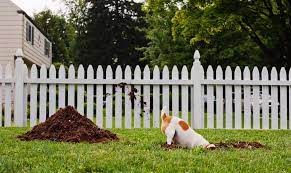When it comes to keeping our dogs happy, one of the most important things for dog owners is their freedom. We want them to have different activities where they will have a lot of exercise and where they can move around and protect them from harm and make sure that they do not harm our neighbours.

So what is the solution? Generally, it depends on the layout of your yard and how your dog escapes. If your yard is not enclosed by a physical fence, rat training is the most reliable solution. If you don’t feel comfortable trusting your dog to stay in an unenclosed area, installing an invisible fence is a reliable alternative. For dogs that run into fenced enclosures, such as fences or chain links, there are many ways to resolve the situation and prevent future attempts to leave the enclosure.
For Yards without Fences: Boundary Training
Whether you own property or live in a neighborhood that prohibits fencing, boundary training is the easiest way to ensure your dog stays in the yard. With proper training and diligence (and the help of a dog trainer), this can usually be controlled within a few weeks. However, the more practice, the better the result. This training requires a clicker. Start by purchasing a flag from a local hardware store. These will be both cues and incentives for your dog to come back to you. Start in a safe place in the house, showing your dog one of the marking flags. Let your dog touch his nose to the flag. Once the flag is drawn, press the button and reward your dog immediately with a treat, preferably high as a piece of chicken or cheese. Do this several times a day for a few days to a week, placing the flag farther apart each time. This helps your dog associate the flag with the reward, because every time he touches the flag he gets a treat. Make sure you always reinforce their good behavior by clicking buttons and treats. Be sure not to reward bad behavior, as this will reinforce the training.
Once the standard indoor practice is done, you can move the arrangement outside. To begin, mark your borders with the flag, leaving 8 to 10 spaces between each. With your dog on a long leash, preferably an adjustable leash that allows about 15 to 20 feet of wiggle room, let him touch the flag. Click directly and get paid for every flag hit. This encourages your dog to come back to you after touching the flag. With enough practice, it will become second nature.
Once your dog starts coming back to you gradually, increase the length of the range and repeat the process. Make sure you always use the leash and pay for the best dog care. This time, include low distractions, such as adding a friend, family member, or other pet to the scene. Adding more complexity to the training will help your dog understand that touching the flag and coming back to you is more valuable than looking for distractions in a fun environment.
When you are confident in your dog’s ability, remove the leash. Be sure to provide plenty of action and clicker setup to encourage more action. This last part of the training can take a long time to master for all dog breeds, so make sure you are 100% confident in your dog’s ability to stay in the yard before you leave him unattended. If your dog has run away, do not punish him. This is one of the most important training mistakes to avoid because poor support does not lead to good training results! Be patient with your pet and feed often.
For Yards with Fences: The Jumpers/Climbers, Diggers, and Patrollers
Jumpers & Climbers
For dogs who know the art of jumping and climbing over fences that want to prevent them from doing so, there are many ways to solve this problem.
- The Oscillot: This is a rolling paddle (also known as coyote rollers) that mounts over your existing dog fence. When your dog tries to climb over the fence, the paddle swings away from him, knocking him back into the fence. This creates the illusion that he can still climb, but once he reaches it, there is no way he can get over the fence properly. This is also useful for keeping coyotes or neighbor cats out of your yard.
- Overhead Netting: Air netting installs on top of your existing fence, resting at a 45° angle to the inside. This prevents the dog from jumping or climbing over the fence. Once your dog learns that the net is preventing him from jumping or climbing, he will avoid trying to escape.
- Landscaping: Although it may sound too good to be true, landscaping that is perfect and high along a fence with large shrubbery can prevent dogs from jumping or climbing. Wood not only serves as a barrier, but also enhances the beauty of your home!
Diggers
For dogs that will stop at nothing to dig under your fence, there are two simple solutions that will save you from having to clean your garden all the time.
Chicken wire: Although not the best solution, chicken wire is an easy and cheap way to avoid digging. You can put it under the fence or even bury it under the soil or grass at the bottom of the fence to prevent your dog from digging. It can be purchased at your local hardware store.
Concrete Footer: Another solution is to pour concrete around the base of your fence. For best results, make sure the bottom of the fence is deep enough to stop even the most stubborn diggers!
Patrollers
If your dog is purposefully roaming the yard, guarding against what it perceives as disturbance, then doing everything it can to protect the situation by Outside, blocking his thoughts is important. Limited vision will reduce your dog’s desire to go outside.
- Fill the gaps between the nails: Bamboo strips or grass fencing is a good solution for filling the gaps between each fence post. This inexpensive system requires only zip ties for installation.
- If you are concerned about the beauty of your floor, a neutral wall is another solution. However, this requires removing the existing fence and replacing it with a new purchased one.
